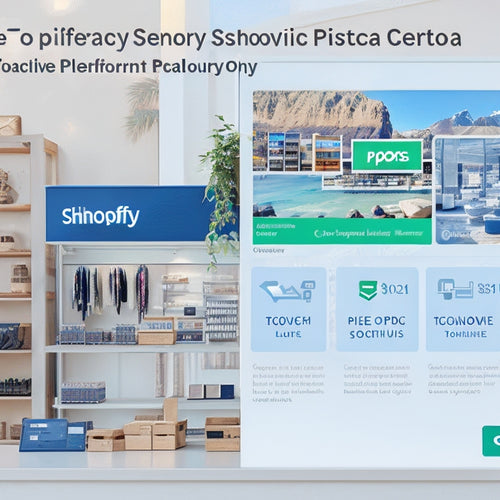
Small Business Marketing Mind Map Unveiled
Share
A small business marketing mind map is a strategic visual tool that integrates essential elements for success. It begins with a solid technical foundation, ensuring streamlined operations and enhanced customer engagement. The map then navigates the evolving ecommerce landscape, leveraging innovative customer engagement strategies and social media for acquisition. Intelligent business insights, derived from advanced analytics, empower data-driven decisions, while marketing strategies open up revenue growth and brand recognition. Agile development methodologies facilitate continuous improvement and adaptation to change. By exploring these interconnected components, small businesses can open up their full potential and stay ahead in the competitive market, and gain a deeper understanding of the intricacies that drive growth and success.
Key Takeaways
• A solid technical foundation enables small businesses to streamline operations, enhance customer engagement, and stay competitive in the digital landscape.
• A multifaceted marketing approach integrating traditional and digital tactics drives revenue growth and brand recognition for small businesses.
• Advanced analytics and business intelligence software provide data-driven insights, empowering small businesses to make informed decisions and gain a competitive edge.
• Agile development methodologies facilitate continuous improvement, adaptation to change, and prioritization of high-impact tasks for small businesses.
• Effective eCommerce integration is crucial for small businesses to stay competitive, providing a seamless customer experience and driving sales.
Technical Foundation for Success
Establishing a solid technical foundation is important for small businesses to effectively navigate the complexities of marketing. It enables them to streamline operations, enhance customer engagement, and drive business growth.
A critical aspect of this foundation is indoor unit installations, which require precise planning and execution. For example, FXDQ-PB and FXDQ-NB indoor units demand specific dimensions and clearance requirements for successful installation.
Additionally, eCommerce integration is essential for businesses to stay competitive, necessitating a seamless connection between online platforms and internal systems.
Evolving Ecommerce Landscapes
As small businesses navigate the complexities of marketing, they must also adapt to the evolving eCommerce landscape, where a highly integrated ecosystem connects companies with consumers, suppliers, and vendors across various channels. This landscape is characterized by constant digital transformation, driving the need for innovative customer engagement strategies.
| Channel | Function |
|---|---|
| Social Media | Customer Acquisition |
| Email Marketing | Retention and Loyalty |
| Mobile Apps | Personalized Experience |
To thrive in this ecosystem, businesses must prioritize digital transformation, integrating their online and offline channels to provide seamless customer experiences. By leveraging data analytics and AI-powered insights, businesses can create targeted marketing campaigns that drive customer engagement and loyalty. By embracing this evolution, small businesses can stay ahead of the curve and reap the rewards of a digitally transformed eCommerce landscape.
Intelligent Business Insights
Intelligent business insights, derived from advanced analytics and business intelligence software, empower small businesses to make data-driven decisions, driving growth and competitiveness in today's fast-paced market. By leveraging these insights, businesses can identify areas of improvement, optimize operations, and create targeted marketing strategies.
Here are three key benefits of intelligent business insights:
-
Data-driven decision-making: Make informed decisions with accurate and timely data, reducing the risk of costly mistakes.
-
Competitive advantage: Stay ahead of the competition by identifying market trends and opportunities before they do.
-
Efficient resource allocation: Optimize resource allocation by identifying areas of inefficiency and streamlining operations.
Marketing Strategies Unlocked
By employing a multifaceted approach that integrates traditional and digital marketing tactics, small businesses can harness the full potential of their marketing strategies, driving brand awareness, customer engagement, and ultimately, revenue growth. To achieve this, businesses can adopt unconventional tactics such as press releases, email blasts, blogs, and social media to reach a wider audience. These cost-effective strategies can help businesses achieve brand recognition while highlighting necessary communication vehicles and skills.
Additionally, incorporating trade shows into marketing goals can further enhance brand visibility. By leveraging these tactics, small businesses can create a robust marketing strategy that sets them apart from the competition and drives long-term success.
Agile Development Methodologies
In today's fast-paced digital landscape, Agile development methodologies have emerged as an essential tool for small businesses seeking to stay ahead of the curve, fostering a culture of continuous improvement and adaptation to change.
Here are three key aspects of Agile development that small businesses can leverage:
-
Iterative approach: Break down complex projects into manageable chunks, allowing for flexibility and quick response to changes.
-
Daily stand-up meetings: Encourage open communication and collaboration among team members, ensuring everyone is on the same page.
-
Prioritized tasks: Focus on high-impact tasks based on product owner feedback, ensuring that the most critical aspects of the project are addressed first.
Effective Communication Tactics
Effective communication tactics are essential for small businesses to convey their message, build brand recognition, and ultimately drive sales, as they navigate the complex landscape of modern marketing.
To stand out in a crowded market, entrepreneurs must adopt innovative strategies that reach their target audience. One such approach is to leverage cost-effective, non-traditional tactics like press releases, email blasts, blogs, and social media marketing. These channels enable businesses to share their story, showcase their unique value proposition, and engage with customers in real-time.
Integrated Marketing Frameworks
Three key elements comprise an integrated marketing framework: a clear understanding of the target audience, a well-defined brand identity, and a cohesive messaging strategy. This trifecta forms the foundation of a successful marketing approach, ensuring consistency across all channels and touchpoints.
To further solidify this framework, consider the following:
-
Technical specifications: Define the technical requirements for each marketing channel, ensuring seamless integration and efficient execution.
-
Channel alignment: Align marketing channels to target audience segments, maximizing reach and engagement.
-
Data analysis: Regularly analyze data to refine the marketing strategy, ensuring best possible ROI and continuous improvement.
Frequently Asked Questions
What Is the Ideal Team Size for Agile Software Development Projects?
For Agile software development projects, the ideal team size is 5-11 members, striking a balance between team dynamics and project management. This enables effective collaboration, boosts productivity, and fosters a sense of ownership among team members.
How Often Should a Small Business Update Its Marketing Strategy?
As market trends shift and customer engagement evolves, a small business should reassess its marketing strategy every 6-12 months to guarantee effectiveness, avoiding stagnation and staying ahead of the competition.
What Is the Recommended Minimum Budget for Ecommerce Integration?
When allocating a budget for eCommerce integration, consider a minimum of 10% of total revenue, ensuring a balanced investment in marketing strategies that drive customer engagement and maximize return on investment.
Can Non-Traditional Marketing Tactics Replace Traditional Advertising Methods?
Non-traditional marketing tactics, such as influencer partnerships, guerrilla marketing, experiential events, and viral campaigns, can effectively replace traditional advertising methods, offering a fresh, engaging, and cost-effective approach to reaching target audiences.
What Are the Key Performance Indicators for Measuring Business Intelligence?
Delving into the truth of business intelligence, we find that key performance indicators (KPIs) such as customer engagement metrics, data analysis, and conversion rates serve as essential benchmarks to measure its efficacy, driving informed decision-making and strategic growth.
Related Posts
-

Integration Shopify Apps Ensure Smooth Interoperability Between the Store and Various External Tools or Platforms Such as POS Systems and Crms
The integration of Shopify apps plays a crucial role in ensuring smooth interoperability between the store and vario...
-

How Do I Choose a Shopify App
The selection of a suitable Shopify app is a crucial decision for individuals seeking to enhance their e-commerce ca...

